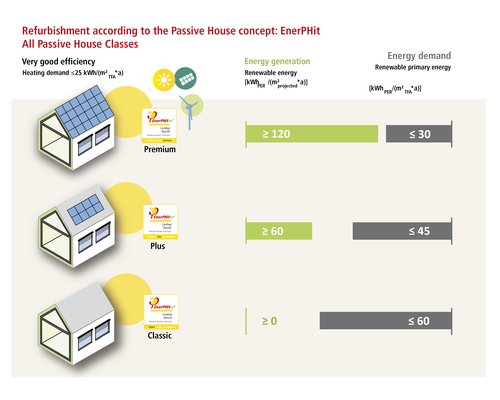Evaluation of RES generation
Passive House Certification: Classic, Plus, and Premium

The Passive House Institute offers three certification classes—Classic, Plus, and Premium—designed to guide the integration of renewable energy into highly efficient buildings. These classes evaluate both overall energy performance and renewable energy generation. While the core Passive House and EnerPHit standards remain unchanged, the certification level depends on the total primary energy demand and the building's renewable energy supply, assessed using the Primary Energy Renewable (PER) methodology. Available for both new builds and EnerPHit retrofits, the higher the energy efficiency and renewable energy production, the higher the certification level.
Available Outcomes
Adequate Net Zero Rating Approach
As outPHit and the EU strive for a sustainable future, it is vital to pick the appropriate yardstick. Inappropriate incentives could cause lock-in effects at a later date, even if they sound reasonable at first glance. This approach picks up on the claims of the most discussed concepts and how they may steer the development, and thus helps project managers navigate through the different concepts of “net zero” to ensure a reliable and robust assessment of building concepts with regard to carbon emissions and the transition to renewable energy sources.
Report on the potential of on-site usage of RES
This report showcases the renewable energy potential in several case study projects across Europe based on their PHPP calculation and in comparison to measured data (where applicable). The publication shows the importance of minimising space heating demand and underlines the benefits of the EnerPHit standard. In addition, it highlights the impact of EV charging and battery storage on the grid load.
PVecon: PV Economy Evaluation Kit
The implementation of renewable energy sources plays a crucial role in increasing the energy efficiency of buildings. However, the evaluation of the possibility to directly use or store the gains within the building or sell the gains to a public grid is tricky, as these concepts depend on the energy demand of the building and the climate of the location considerably. Besides mere financial considerations, the ability to use or store PV energy within the building is also relevant for the future energy supply, when the energy storage within buildings will and the prices and funding for selling PV electricity or own use vary greatly from country to country.
This tool helps to assess PV self-consumption potential of a building, the possibility to improve the self-consumption ratio by temporarily storing PV electricity within a building, and supports evaluating the economic potential of selling PV to the grid. It allows the user to receive information extent to which RES implementation makes sense to supply the building with energy, and if the revenues of the PV electricity either saved or sold to the grid can compensate or exceed the investment costs.
